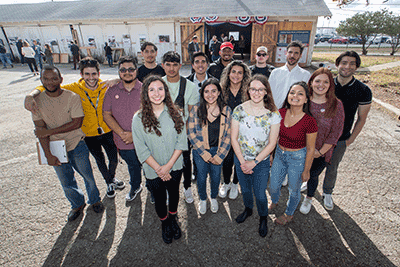
Photo courtesy of Material Innovation Center
When older buildings come down in San Antonio, the Material Innovation Center (MIC) works with contractors and donors to recirculate salvaged woodwork, windows and other construction materials, such as lumber and siding, for use—at no cost—in local affordable housing construction projects.
By reinvesting these valuable materials into local properties, the objective, says urban planner and policy maker Shanon Miller, is to repair, restore and extend the lives of homes in the community, as well as to increase affordable housing. Under Miller, manager of the San Antonio Office of Historic Preservation’s first Deconstruction and Circular Economy Program, the San Antonio City Council adopted a deconstruction ordinance, which went into effect in October of 2022 and requires properties over a certain age that are approved for demolition to be deconstructed rather than demolished.
“I’ve been interested in the community revitalization benefits of historic preservation for my whole career,” Miller says. “A lot of people in this role tend to come from an architecture background. I studied history and economics, public service. It’s really about the community benefit for me.”

Deconstruction, she explains, drastically reduces the amount of construction and demolition (C&D) waste that goes to landfill while maximizing salvage for reuse and advancing the city’s climate action, public health, affordable housing, cultural heritage and workforce development goals.
With deconstruction, “basically we take the house down in the opposite way it went up,” Miller says. “We start with the last thing, so we take the roof off, and un-construct it from there.”
The process is more labor-intensive than using a bulldozer, but it does not pollute the air to the extent of a mechanical demolition, Miller explains, and the amount of C&D waste generated is much less than in a typical demolition.
RELATED: Armstrong partnership eyes landfill diversion | Path to diversion
The MIC is a city initiative run on a limited budget by a dedicated group of city employees. The city rents warehouse space for the program at no cost in the Bungalows at Port San Antonio, a historic colony that was originally constructed to house military officers. Now, the bungalows and attached garage structures serve as storage space for reclaimed materials as well as a home for workshops, hands-on training courses and a community tool library. Donated materials are organized by type into different garage bays.
Additional funding for the program is provided through grants from community partners including Rehabarama, a housing preservation program that pairs contractor volunteers with homeowners to complete home repair and maintenance projects, and the Living Heritage Trades Academy, which offers tradespeople hands-on apprenticeships and workforce development partnerships.
While other cities, such as Portland, Oregon, have deconstruction ordinances, and cities such as Houston have reuse facilities, Miller says she doesn’t know of another program that comes from the same preservation perspective as San Antonio’s.
“I don’t know of anyone else who has that direct a tie to affordable housing, where the material goes at no cost back into affordable housing,” says Miller, who explains the ordinance was written with an intimate understanding of the cultural and economic value of materials being lost.
.gif)
As part of the city’s deconstruction ordinance, MIC representatives will make contact with property owners who are going through the required permitting and approval process to inform them of all the options available for the disposal of C&D materials. Ultimately, it’s up to the property owner where the material will go, Miller says. Some choose to reuse the items, and some sell them directly to an architectural salvage store or another entity that has use for them. An alternative option is to donate them to the MIC.
“We’re not intended to compete, but really to be the last stop. You can think of it as the last stop before the landfill,” Miller says. “There are lots of reasons why buildings come down, and all of that quality material could be going into other historic properties.”
Due to the nature of the housing stock in San Antonio, according to Miller, much of what comes through the center is wood, and those high-quality framing boards, siding, windows and doors can be reused to help rehabilitate the city’s housing stock.
“What I’m most excited about is the fact that we’re able to take material and use it at no cost in someone’s home that helps to extend the life of that property,” Miller says. “So often, the property gets to the point of demolition because someone didn’t have the resources to do maintenance. That’s what really gratifying.”
Latest from Construction & Demolition Recycling
- LRS diverts 330,000 tons of recyclable material in 2024
- Elevating industry standards
- Takeuchi adds dealer locations in central US
- Tariffs target steel exporters Brazil, Canada and South Korea
- Toyota-Tsusho completes acquisition of Radius Recycling
- Motion opens new branch in Quebec
- Terex M515 trommel designed for rip rap production
- Lippmann adds dealer in Pacific Northwest





